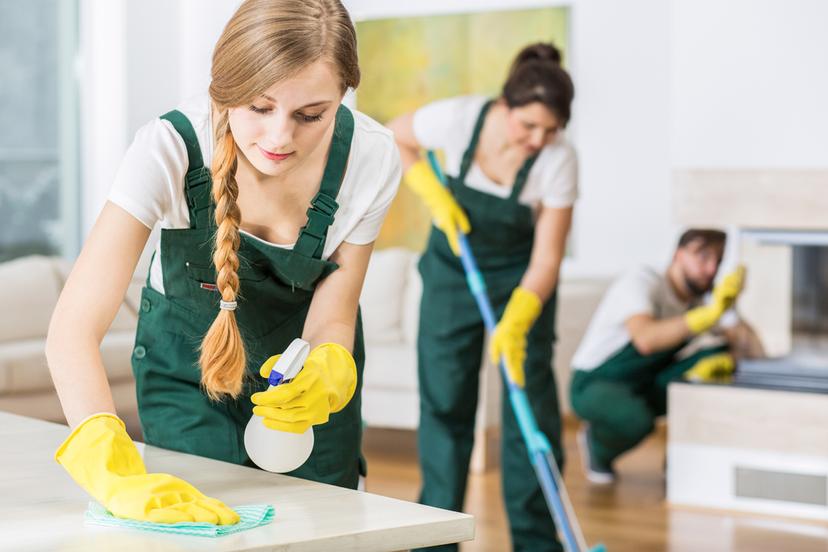Personal Care and Services

Structure
Maids and housekeepers are responsible for keeping homes, workplaces, hotel rooms, and other types of environments clean and orderly. They vacuum rugs, sweep and mop floors, clean tabletops and appliances, dust furniture, empty wastebaskets, take garbage out to disposal areas. They change linens and make beds, and replace towels in bathrooms. Other responsibilities may include replacing supplies like soap and shampoo, washing and folding clothes, shopping for groceries, preparing meals, dropping off and picking up dry-cleaning, and other errands. Maids and housekeepers work full-time or part-time hours. Much of the work is physical and requires a level of fitness and stamina to avoid injuries and illnesses. Private homes employ maids and housekeepers directly through word of mouth or through employment agencies. There were 924,290 maids and housekeeping cleaners employed in the United States in 2018. Nearly 25 percent worked for the traveler accommodation industry.
Personal care aides are also known as personal attendants and caregivers. They help people with disabilities and elderly people with daily self-care tasks and activities, such as bathing, brushing their teeth, cooking meals, and cleaning. They play games and take people on walks to keep them active and engaged. The work may also involve general housekeeping tasks, grocery shopping, and accompanying the client to doctors’ appointments. Personal care aides differ from home health aides in that they cannot provide medical services. There were more than 2.2 million personal care aides employed in the United States in 2018. The majority work for individual and family services, home health care services, and residential facilities and retirement communities.
Pet sitters look after pets while their owners are away from home. They might take care of animals during the day while people are at work or tend to pets for several days or more while people are out of town. They travel to people’s homes to feed, walk, and play with their pets. They may also be responsible for cleaning and changing litter boxes and cages. In some instances pet sitters are paid to stay in the home for the duration of the owner’s trip, ensuring the pets are in their familiar environment and have constant company and attention. If they notice the pet behaving oddly or showing signs of illness, they notify the owner first to discuss next steps, such as trip to the vet. Pet sitters with more experience may offer services such as bathing, grooming, and training pets. Most pet sitters work directly for pet owners. Self-employed pet sitters are required in some states to have a business license. Pet sitters enhance their skills and improve their chances for securing work through certification from groups such as the National Association of Professional Pet Sitters and Pet Sitters International.
The Department of Labor includes tree trimmers and pruners; pesticide handlers, sprayer, and applicators; and landscaping workers in the grounds maintenance workers occupation. Tree trimmers and pruners usually work under the direction of a supervisor, manager, or the owner of the landscaping or tree trimming company. They work outdoors, often in teams of least three or more people, always paying close attention to the work they are doing and communicating with each other. They use chainsaws, wood chippers, and other dangerous equipment, which is why they wear hard hats, eye protection, ear plugs, and gear to protect them in case of a fall. Tree trimmers and pruners train on the job and can also receive certification from organizations such as the International Society of Arboriculture and the Tree Care Industry Association. In May 2018, there were 42,440 tree trimmers and pruners working in the United States.
Pest control workers treat plants and soil with insecticides, fungicides, and herbicides to control or prevent insects, weeds, and diseases. If they work for tree service or chemical lawn companies, they specialize in analyzing lawns and creating treatment plans to solve problems such as insect infestations or weeds. They use fertilizers to stimulate lawn growth or pesticides to tackle insects.
There are also pest control workers who inspect homes, buildings, and surrounding areas for pests such as ants, termites, bedbugs, roaches, mice, and rats. They know how to identify the pests and design and carry out pest control and removal plans. Jobs in home and building pest control include pest control technicians, who conduct inspections and design pest control strategies and work directly with customers. There are also pest control applicators, which include termite control technicians, who not only apply chemicals to eliminate termites but also repair structural damage and build barriers to prevent termites from having access to food sources. For larger scale infestations, fumigators are called upon. Fumigators seal the building and flood it with gases to kill the infestation. They post warning signs before beginning their work to keep people out of the building until the work is completed. All pest control workers wear gloves, goggles, and either protective masks or respirators, depending on the chemicals they use on the job. All states require that pest control workers be licensed. There were 77,300 pest control workers pesticide handlers, sprayers, and applicators employed in the United States in 2018. Most work for companies that provide services to residential and commercial buildings. The states that offer the most job opportunities for pest control workers are Florida, California, Texas, Georgia, and North Carolina.
